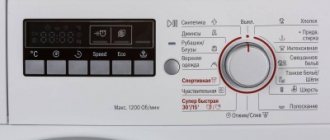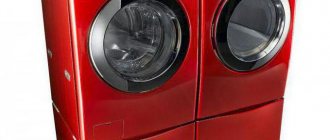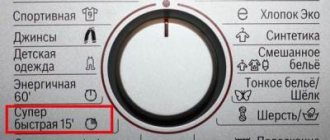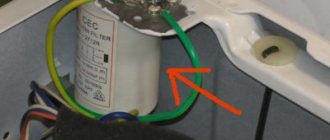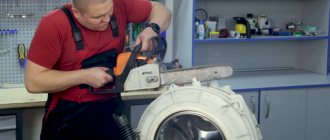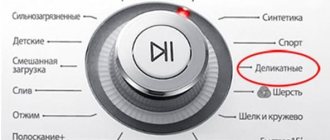A test run of an automatic washing machine is carried out in a special mode: without laundry in the drum, at maximum water temperature and with a special anti-factory detergent. Such recommendations are given by manufacturers of household appliances to their customers.
The first run of a washing machine is often called experimental or test. Its purpose is to check the functionality of the parts and components of the device, remove traces of grease and unpleasant odors. A correctly carried out test wash ensures a long service life of the device and helps to identify manufacturing defects.
Preparing to start the washing machine
Before testing, the machine is installed and connected to the water supply, sewerage and electricity supply. Preliminary preparation consists of several stages.
- A new washing machine delivered from the store is unpacked and inspected. You cannot sign acceptance documents before this! Visually, you can determine serious mechanical damage: dents, scratches, cracks on the hatch. At the same time, they check the completeness - the presence of hoses, the integrity of the power cord and plug. If you forget about the preliminary inspection, it will become impossible to prove the presence of a manufacturing defect.
- Factory packaging items are stored in case of breakage during the warranty period. Some manufacturers require that the faulty machine be returned in the original box and frame.
- There are transport bolts on the back surface of the washer. They secure the drum during transportation. The fasteners are removed and the holes are closed with plastic or rubber plugs.
- After this, the unit is installed in the selected location. The floor under the machine must be strong and level. It is advisable to install by level; The maximum permissible angle of inclination of the base is two degrees. In this case, the device will stand still in any operating mode (washing, rinsing, spinning).
- The water supply hose is connected to the water supply, the drain hose is connected to the sewer pipe. If it is not possible to drain directly into the sewer, firmly attach a corrugated hose to remove water at the edge of the sink or bathtub.
- The water supply valve on the hose must be open, otherwise the pump will fail after a few minutes of idle operation.
- To power your washing machine, you must have a grounded outlet designed for high-power consumer electronics. It is not advisable to use extension cords.
- At the end, the device is inspected again, small packaging parts (film, adhesive tape) are removed, and the drum and detergent tray are checked for the presence of foreign objects and debris. The washing machine is ready for a test run.
Important! During the cold season, the machine is kept indoors at room temperature for 5–7 hours. This is necessary to ensure that all components and parts (especially the electronic control unit) operate at their usual temperature conditions.
What to pay attention to during the very first wash?
Test activation of the device is an opportunity to check it, among other things, for correct operation, for absence of leaks, as well as for correct connection to the sewerage system and water supply.
If a leak is detected, you must immediately stop the operation of the unit, drain all available water, and call a specialist to your home so that he can identify the cause of the problem. Only when the problems are completely eliminated can the device be used again.
If the first test wash went well, you can now use the equipment constantly, following the instructions (from it you can find out information about the maximum load of the tank with clothes and the recommended amount of powder used).
If after starting the equipment rattles, the first thing you will need to do is contact the nearest service center. He can repair the machine free of charge under the warranty card. When calling the service, you should describe the problem in as much detail as possible. The technician will pick up and repair the equipment, and then return it back.
It also happens that the machine begins to make noise due to the fact that it is standing on an uneven or unstable surface. This should be checked. In addition, extraneous sounds may appear if the transport bolts were not initially removed due to carelessness.
When using, you need to wipe the equipment body frequently with a chlorine-free product. Moisture and remaining dirt should be removed under the rubber seal. The drain filter also needs to be cleaned more often to remove clogging.
To wash clothes, you should use only special powders and other products intended specifically for machine washing. They should not be replaced with powders that are intended for hand washing clothes. If you break this rule, then in the end, in addition to the fact that the dirt will still remain on your clothes, the device may break.
This is due to the increased foaming that occurs when washing detergents are used by hand. It is recommended to first find out the hardness of the water in the tap, so that it is easier to select the appropriate type of powder and select the right amount.
It is recommended to regularly descale the heating element using vinegar; citric acid will also work.
It is important to try to put fewer items in the wash, otherwise the unit may be overloaded and its individual parts may wear out. And before loading things into the drum, be sure to check the pockets of your clothes; there should be nothing unnecessary there.
When starting work, check whether the machine is connected. The device must be plugged into the electrical network, and it must also be connected to the sewerage system and water supply. It is also necessary to check that the tap that shuts off the water in the hose is open. The loading tank of the unit must be closed. If loading is horizontal, just close the door.
With the vertical type of loading, the drum is first closed, after which the loading hatch is closed. At the end of the procedure, leave the door open for ventilation. In its absence, mold may gradually appear inside, and then it will be difficult to clean.
Don't worry if you can't open the hatch after completing the first wash. It is better to wait for some time until the blocking is no longer in effect. After this, all you have to do is pick up your things and dry them thoroughly. Usually the blocking lasts no longer than 3 minutes (usually less).
The lock is needed to ENSURE the user's safety. So, if it is not there, a person can completely accidentally open the door during the washing process, then all the water will immediately pour out on him. And if it turns out to be hot, the person will immediately be scalded with boiling water.
The presence of a lock allows you to protect both adults and small children if they accidentally find themselves near a working device.
If you immediately start using the device, taking into account all existing rules, strictly in accordance with the instructions, you will be able to avoid breakdowns and extend its service life. So it is imperative to study the instructions and always follow its rules.
Even if you previously had to use certain models of machines, it is better to familiarize yourself with the requirements set by the manufacturers for this particular device, because they may turn out to be slightly different.
Tool for first starting the washing machine
The purpose of a test wash in a new washing machine is to remove technical contaminants (grease, oil and solvent residues).
We recommend: How can you wash a feather and down pillow at home?
Special tools are suitable for this:
- set of ORO tablets. The first cleaning agent (labeled “Clean”) is used during a test run of the machine. The second (marked “Calk”) is added when descaling after long-term use (25–30 washes with maximum load);
- Helfer Start drug (for starting and preventing washing machines). It removes foreign technical substances and odors from the metal surfaces of the device
- WIMAX powder for dissolving oil residues and other factory contaminants.
During the first wash, you can use regular washing machine powder. It is recommended to fill the detergent compartment with about half the usual amount: this is enough to remove odors and dirt.
Step-by-step instruction
A trial run of an automatic washing machine of different brands is carried out almost the same way. Minor differences are reflected in the operating instructions for the specific model, so please read the relevant sections of the brochure before washing for the first time. The types of detergents for a test run do not differ: you can use any special composition or powder for automatic machines.
Launch of LG washing machine
Most LG models will be tested using a single algorithm.
- The machine is connected to the water supply, sewerage and connected to the network.
- Place detergent in the tray (half the dose recommended in normal mode).
- Select the “Cotton” program, set the temperature to 90⁰C and the minimum number of spin speeds (400 or 500).
- Close the door until it clicks.
- Turn on the "Start" button.
During the entire “wash-spin-rinse” cycle, the machine is monitored and leaks and engine noise are monitored. After automatic shutdown, open the hatch, wipe the rubber cuff and drum. It is recommended to ventilate the car for 2–3 hours. The next wash is carried out as usual, selecting a program according to the type of item and the intensity of contamination.
Launch of Haier washing machine
Preparing for a test wash in a Haier machine is easy:
- remove the shipping fasteners;
- the unit is connected to communications;
- check the drum and tray for foreign objects;
- Load the detergent for the first start of the washing machine or automatic powder into the compartment (no more than half the norm).
For the first use, start the “Drum Cleaning” program. The mode is selected by turning the knob located on the display. Washing is carried out without laundry at a preset temperature of 90⁰C with a spin speed of 600 rpm.
Launch of Samsung washing machine
The first wash in a Samsung automatic machine is carried out according to standard rules:
- remove the bolts securing the drum during transportation;
- connect water and electricity to the device;
- inspect the drum and remove small debris and dust;
- Laundry detergent or liquid detergent is placed in the tray. Enough is 100 g of dry product or 80 ml of liquid.
Depending on the model, select the “Cotton” or “Eco Drum Clean” program. The test run is carried out at a temperature of 95⁰C and minimum spin speed (400). On average, a test wash takes a little over an hour.
We recommend: What is the easiest way to wash a large soft toy?
Launch of the Indesit washing machine
A test run of the Indesit machine can be carried out immediately after the unit is installed in a permanent place and connected to the water supply and electricity system. A detergent for the first wash in a machine or regular powder with reduced foaming is placed in a special compartment.
In older models, the temperature (90⁰C) and the number of revolutions (400–600) are set using adjustment knobs on the panel. In new Indesit machines, they select the “Drum Self-Cleaning” program. The test wash is carried out without laundry and with half the amount of powder.
Selecting the appropriate mode
When checking the operation of the device, you need to choose the right program. Modern machines are distinguished by a large number of possible modes, as well as the presence of a convenient program for quickly washing things.
Sometimes equipment is equipped with various additional functions, for example, a mode for disinfecting things, which will undoubtedly be very useful.
When choosing the appropriate mode, you need to take into account temperature indicators. The wrong choice of temperature can ruin some or all of your items. It is important to note: all models have their own controls.
Thus, budget devices have a special small adjustment wheel designed to select the most suitable program. In expensive devices, setting the mode is possible using a convenient touch panel.
After preliminary preparation of the unit, you need to put the prepared clothes in the tank and pour the required amount of powder into the dispenser tray. Then you need to click the “Start” button located on the control panel. The device will start working.
In what cases should you contact a specialist?
During the first start-up, the machine is not left unattended. After turning on, listen to the engine: the engine should not growl or grind. Observe the tightness of the hose connections and leaks from under the bottom of the machine.
If the engine runs rhythmically and without excessive noise, there are no leaks, the hoses are connected securely, water is poured and drained without difficulty - the test run was successful. The washing machine can be used for its intended purpose and run any program.
Contact a specialist if the motor makes uncharacteristic sounds, the machine vibrates or moves during operation. The help of a specialist is necessary in case of leaks, especially if puddles flow from under the bottom of the unit.
Important! You cannot fix problems with new equipment yourself. The washing machine is under warranty for a year; service center specialists will fix the faults free of charge.
Recommendations for caring for your washing machine
The average service life of an automatic washing machine is 7–10 years. To ensure that the equipment operates without breakdowns during this time, follow the simple recommendations of specialists.
- The machine is not overloaded. The maximum weight of laundry for one run is indicated in the instructions for the device, and you should not exceed the norm. Experienced housewives advise not to load the machine “to the maximum”: this way things are washed better.
- Spinning at high centrifuge speeds (more than 1000 per minute) greatly wears out the motor, bearing and destroys the crosspiece. You should not constantly use intensive spinning.
- For washing, use washing powder for automatic machines, gel or capsules. You should not exceed the norm of detergents: this will negatively affect the condition of the machine and laundry. Do not put hand wash detergent into the tray!
- Hard water has a negative effect on the condition of the water heating element. To soften, use detergent with special additives.
- After 30–40 washing cycles, turn on the drum self-cleaning mode or carry out a dry wash with a special product.
- If the machine has a removable filter, it should be cleaned regularly.
- After completing the wash, wipe the machine dry from the inside. Take special care to remove any remaining water from under the rubber cuff.
- For several hours after the device is turned off, the hatch door is not closed. This will prevent mold from forming inside the tank. It is also useful to ventilate the detergent tray.
With careful care, the washing machine will last for many years without breakdowns.
Useful tips
If you want to reduce your electricity consumption, you need to follow these helpful tips.
- Do not machine wash items that are only suitable for hand washing. Information about this can be easily found on product labels,
- It is forbidden to overload the device more than intended (information about this must first be obtained from the instructions and followed).
- It is important to prevent metal parts from getting into the device; they can damage the drum and the clothing itself.
During the first use, it is advisable to pour into the device a special product intended for the first machine washing of clothes. It is taken in small quantities, less than is usually required.
The product for the first launch is sold in specialized stores. For example, you can purchase Helfer Start. This composition is suitable for almost any model of newly purchased cars.

